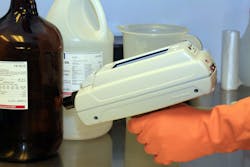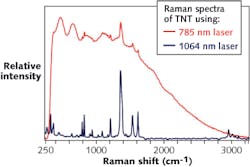PHOTONICS APPLIED: HANDHELD SPECTROMETERS: Spectrometer miniaturization redefines real-time sensing

“Borrowing a term from Star Trek, today’s spectrometers are modern-day ‘tricorders,’ helping warehouse operators speed-up identification and certification of incoming materials, detecting counterfeit drugs at border crossings, identifying possible bioweapons in airports or on the battlefield, and assisting first responders and firefighters with investigating suspicious substances or chemical spills,” says Eric Bergles, VP of sales and marketing for BaySpec (Fremont, CA). “They can also discover early onset of glaucoma during eye exams, measure defects on solar cells, provide early detection and diagnostics on cancer cells, and analyze high-yield, renewable biofuels needed for the next generation.”
Tradeoffs in size and performance
“With spectroscopy there are always tradeoffs between size and performance; however, the telecom boom and bust had a Manhattan Project effect on the development of lasers and optical components,” says Bergles. “Ten to fifteen years ago, optics, lasers, and detectors were limited to laboratories on bulky optical benches with sophisticated liquid nitrogen cooling and complicated alignment/operations requiring a PhD. Today—without sacrificing performance in many cases—lasers are the size of your little finger; Newton’s prism has been replaced by a high-throughput holographic volume phase grating; and detectors can be thermoelectrically air-cooled, doing away with liquid nitrogen,” he adds. “Using low-profile, surface-mount electronics completes the picture, enabling spectrometers the size of your Blackberry or iPhone.”
“The ability to build spectrometers around less expensive detectors, advances in personal computers with phenomenal spectral data acquisition, processing, and storage capabilities, and mass production of optical fiber for easy light guiding from the sample to the detector have enabled the modern handheld spectrometer,” says Rob Morris, director of marketing at Ocean Optics (Dunedin, FL). “Our USB2000+ spectrometer has a footprint not much larger than a mobile phone and weighs about 190 g, yet spans a wavelength range from 200–1100 nm with a signal-to-noise ratio of 250:1 and an optical resolution from 0.3–10.0 nm full-width half-maximum—rivaling many benchtop devices on the market.”
“Just as companies transformed the telecommunications industry from landline to wireless and beyond, we are transforming the $40 billion analytical and life sciences instrument market to provide life-saving information in a mobile format,” said Doug Kahn, VP and GM of the Portable Optical Analysis business of Thermo Fisher Scientific (Waltham, MA), created by the 2010 acquisitions of Ahura Scientific and Polychromix. Their 1.8 lb. FirstDefender RM Raman instrument requires no scheduled maintenance or calibration. And weighing less than 2.9 lbs., the TruDefender FT is Thermo Fisher’s handheld Fourier-transform infrared (FTIR) spectrometer that complements FirstDefender to maximize in-the-field coverage of an even broader range of unknown chemicals.
“While both FTIR and Raman spectrometers cover similar wavenumber ranges and can both detect about 90% of desired substances, there are important differences,” says Dustin Levy, product manager at Smiths Detection (Danbury, CT). “FTIR sees through the natural autofluorescence of many samples that confounds Raman detection, while Raman works better on the many samples that contain water since, unlike FTIR, it can see through that spectral water peak.” In some of its systems, Smiths Detection combines both Raman and FTIR spectra for a definitive result.
And while most handheld devices are FTIR or Raman-based, mid-infrared spectrometers have entered the mix, with small quantum-cascade laser sources from companies like Daylight Solutions (Poway, CA) that promise to expand the handheld spectroscopy market even further.
From rocks to cocaine to lizards
Spectrometer portability has enabled a myriad of applications not possible in a laboratory setting.1 Intevac Photonics’ DeltaNu (Laramie, WY) portable Raman systems use patented “free space” technology wherein low-power laser diodes (<100 mW) eliminate sample damage. A frequency-stabilized 785 nm laser diode light source irradiates the sample and scattered photons are collected with a lens, then filtered and dispersed across a CCD found in most grocery cart scanners and digital cameras, creating a spectral fingerprint of the substance being measured.DeltaNu says it developed the first handheld Raman system in 1993—the Inspector Raman/RockHound (see Fig. 1). Marketed to geologists for mineral identification, it weighs in at less than 5 lb and uses Bluetooth to communicate with a laptop computer. In addition to a spectral library of approximately 500 common minerals, unknown minerals can be identified with a publicly available Raman mineral database provided by Bob Down’s group at the University of Arizona (Tucson, AZ) called RRUFF.2 The RockHound also has a Raman microscope attachment for detailed microspectroscopy studies in the field, allowing the user to pinpoint the laser on a very small (<50 μm) portion of the sample.
Even more compact and ruggedized than the RockHound are DeltaNu’s ReporteR and Rapid-ID Raman spectrometers. Weighing just 14 oz, built-in LED screens display the name of an unknown material from the stored spectral library—the ultimate “answer box” for the layman. The ReporteR is targeted toward law enforcement with a library of illicit drugs and explosives (see Fig. 2). In some narcotic cases, only a residual amount of illicit drug is confiscated. The shortcoming of chemical pouch and swab kits is that the evidence is consumed and destroyed in the test, exposes the officer to toxic chemicals, and requires interpretive color changes. The ReporteR allows nondestructive testing on sample sizes <100 mg and archives the results and evidence for later retrieval (and immediate conviction). A library of approximately 1500 samples is used for identification of narcotics, explosives, and hazardous substances. The Rapid-ID is targeted toward the industrial inspection markets with spectral libraries for plastics, pharmaceuticals, and chemicals.Smiths Detection credits a database of 17,000 liquid chemical signatures and 35,000 total material signatures onboard some of its portable spectrometers for capturing the sole-source supplier position at the US Transportation Security Administration (TSA) for aviation screening of hazardous liquids. “The key requirement at TSA was to reduce Raman identification time from a typical 2 min to a desired 20 s,” says Aaron Gagnon, director of product management at Smiths Detection. “One way was to crank laser power—not good for potentially explosive liquids! But another way was the path we took: to optimize signal collection. Our RespondeR BLS [bottle liquid scanner] uses advanced chemometrics and a proprietary data-analysis algorithm that met TSA’s rapid-scan requirements.”
Real-Time Analyzers’ (RTA; Middletown, CT) portable Raman spectrometers have a 1064 nm excitation source that avoids fluorescence interference associated with many dispersive Raman instruments. For example, the explosive TNT fluoresces when excited with a 785 nm laser and the single dominant peak is insufficient for proper identification (see Fig. 4). “Our Raman spectrometers don’t require repeated calibrations in the field or laboratory because we use an interferometer with superior x-axis stability compared with a dispersive spectrometer,” says Wayne Smith, VP at RTA. “An internal reference clocking laser with a phase-locked quadrature design provides precise x-axis position monitoring of the peaks; other proprietary design features make our spectrometers relatively immune to ambient temperature changes.” He adds, “Because Raman is a very weak scattering effect [the detection limit is typically 1% for most Raman active molecules and sometimes down to 0.1% for extremely strong Raman scattering materials], research is ongoing in surface-enhanced Raman spectroscopy [SERS]. By using nanoparticles [typically gold or silver], it’s possible to achieve detection limits down to the ppm and ppb level,” says Smith. “Our Portable Residue Detector is a Raman analyzer that utilizes our patented SERS substrates to detect certain SERS-active analytes at very low concentrations.”Rather than supplying turnkey instruments, Horiba Jobin Yvon (Edison, NJ) supplies the OEM requesting a proprietary “black box” with miniaturized CCD or photodiode array (PDA) spectrometers (for Raman, fluorescence or absorbance/reflectance), mini Raman probe, and lasers (532 to 785 nm) customized for the application. Their smallest PDA spectrometer uses an ultrashort focal length (20 mm) concave holographic grating and measures just 22 × 35 × 14 mm3 and less than 50 × 50 × 50 mm3 when including USB electronics. Such compact designs are integrated in colorimetry handheld units used by hardware/paint stores for color matching. On the Raman side, Horiba’s handheld spectrometers—including a high-sensitivity back-thinned CCD—reach 102 × 65 × 34 mm3. “We can extend our detection limit down to parts per trillion when combining SERS and other patented technology from our customers for gas- or liquid-phase chemical detection,” says Nick Vezard, VP of Horiba’s OEM Spectroscopy Division. PerkinElmer’s (Salem, MA) Illumination and Detection Solutions business also takes an OEM approach to handheld spectrometers, supplying both complete solutions or optical components and customized miniaturized light sources based on their pulsed xenon or solid-state LED technologies.
With a small form factor of just 127 × 39 × 91 mm, B&W Tek’s (Newark, DE) handheld Compass-X thermoelectrically cooled spectrometer is for applications where lower light levels and longer integration times are necessary. Operating in the range from 200–1050 nm, it addresses applications in cancer detection and chemical threat monitoring, as well as emerging applications in solar irradiance measurement and LED testing that present new challenges to optical sampling.
Improved sampling
An added feature of many miniature spectrometers is fiber coupling, which makes it easier to bring remote sample data to the detector. StellarNet’s (Tampa, FL) radiometrically calibrated, fiber-optically coupled, miniature dual-channel spectrometer (DUAL-DSR) systems are specifically designed for solar radiation applications, providing watts/area, radiant flux, and lumen output values. The rugged instruments integrate two detector arrays to cover the 200–1700 nm range and include an SMA905 fiber-optic input for attachment of various sampling accessories including cosine receptors and miniature integrating spheres. “Another benefit of miniature spectrometers is a price point under $2000, making them available to a wider audience of consumers,” says Jason Pierce, one of StellarNet’s chief technicians. “Spectral characterization of street lights, dashboard displays, and integrated LED products are just some of the applications suited to low-cost devices.”
Spectral Evolution (North Andover, MA) also offers fiber-coupled spectrometers calibrated to measure spectral radiance and irradiance to quantify the light output and spectrum of LEDs or simulated solar sources using multiple silicon and InGaAs photodiode arrays that span 350–2500 nm. “Because some solar simulator systems are quite large—about the size of a small vehicle, it’s critical to have portable spectrometers to bring to the task,” says Maurice Kashdan, marketing and sales head at Spectral Evolution.In addition to solar irradiance measurements using its Jaz modular sensing suite (see Fig. 5), Ocean Optics’ fiber-coupled spectrometers span a diverse range of applications, from monitoring the amount of light absorbed by phytoplankton or fluoresced by corals, to measuring the reflectance of bird plumage or reptile skin to better understand the nature of color-based mate selection. “In Puerto Rico, spectroscopic equipment has helped biologists learn more about the ultraviolet reflectance of lizards’ bodies, which plays a role in lizard socialization,” says Jason Eichenholz, CTO at Ocean Optics. “Color also plays a role in mate selection among the cichlid fish of Africa’s Lake Victoria. And we’ve also had researchers use miniature spectrometers to monitor the ozone atop Mount Everest, monitor the exhaust plume of rockets, and search for water on the moon.”
REFERENCES
1. R. Cox, “Analytical Instrumentation,” The Forensic Technology Review online magazine 2010, 71–76, www.forensics-news.com/2010review/ (2010).
2. http://rruff.info
About the Author

Gail Overton
Senior Editor (2004-2020)
Gail has more than 30 years of engineering, marketing, product management, and editorial experience in the photonics and optical communications industry. Before joining the staff at Laser Focus World in 2004, she held many product management and product marketing roles in the fiber-optics industry, most notably at Hughes (El Segundo, CA), GTE Labs (Waltham, MA), Corning (Corning, NY), Photon Kinetics (Beaverton, OR), and Newport Corporation (Irvine, CA). During her marketing career, Gail published articles in WDM Solutions and Sensors magazine and traveled internationally to conduct product and sales training. Gail received her BS degree in physics, with an emphasis in optics, from San Diego State University in San Diego, CA in May 1986.



